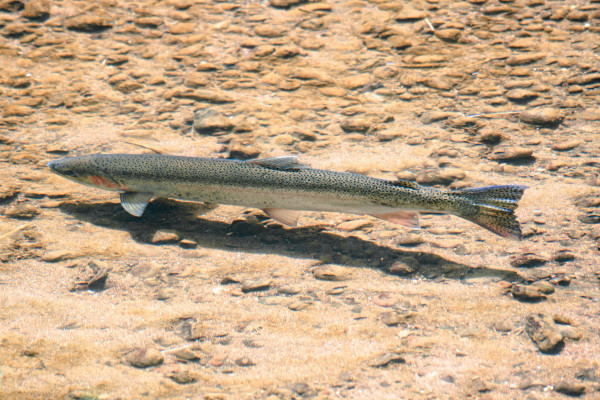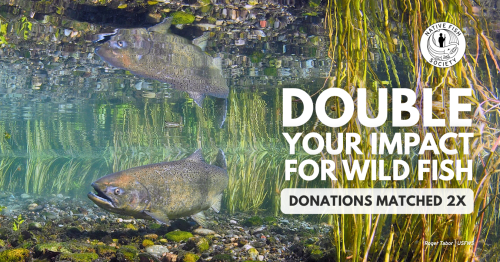Wild steelhead decline in the Pacific Northwest’s Columbia Basin has been the object of intense focus for fisheries managers and agencies in the region over many decades. During the same period, disturbing trends in steelhead populations in the streams along Oregon’s coast have gone potentially unnoticed and certainly unmentioned by the Oregon Department of Fish and Wildlife (ODFW). In fact, our beloved Oregon Coast steelhead may be heading for extinction at an alarming rate.
NFS conducted an analysis of historical and state data on Oregon coast steelhead. This analysis correlated data from cannery records, state data compiled through the Kenanston study in the 1980’s, and current Oregon Adult Salmon Inventory and Spawning data (OASIS data) through 2018. Research strongly suggests a 90% ongoing decline in the Nehalem River since the 1920’s, and coast-wide department data indicate that steelhead in most rivers have been declining at a rate of 20-24% per decade since the 1980’s. According to fisheries biologist and Native Fish Fellow Dr. Chris Frissell, Oregon coast steelhead are on course towards extinction in the next 50 years.
Despite this massive decline, the state regards the Nehalem River’s winter steelhead population as generally strong and healthy - a perfect example of “shifting baselines” - where each successive generation of people believe the diminished fish runs they see are in good condition. This problem will continue to persist without constant monitoring and evaluation.
Making this problematic situation even more concerning is ODFW’s decision to remove coastal steelhead from the state sensitive species list during the creation of the Coastal Multispecies Management Plan adopted by the ODFW Commission in 2014. This decision was made despite the department’s own data indicating that steelhead populations are in significant decline. Since 2014 3 of the 4 populations of coast steelhead have returned at less than their bare-minimum conservation thresholds as set forth by the department in the Coastal Multispecies Management Plan.
Research and analysis by the National Marine Fisheries Service (NMFS) in 2008 evaluated concerns with Oregon coast steelhead and their potential to be an endangered and threatened species. In 1998, Oregon coast steelhead were listed by NMFS as a “Species of Concern.'' This designation along with further analysis in 2008 came from a distinct conclusion by the biological review team that the Oregon coast ESU of steelhead trout is likely to become endangered in the foreseeable future. Two factors led to the findings, short- and long-term declines in populations in the ESU and substantial contribution of non-native hatchery fish into natural escapements in most basins.
Considering these factors NMFS made another key finding, abundance information in this ESU was sparse and may not accurately represent the status of naturally spawned steelhead in this region. They also believed that additional monitoring of the ESU was necessary before it could be eliminated from ESA consideration.
When looking at all the data collected and used to determine population trends and abundance, Native Fish Society found another large gap in monitoring. The only data being collected on adult steelhead in the south coast and Rogue strata is voluntary harvest cards from anglers, creel surveys, and juvenile data collected from snorkel surveys. This data cannot possibly give adequate population numbers to form conclusions on adult abundance within these watersheds.
Effective natural resource management requires effective monitoring and evaluation of populations. In the case of Oregon coast steelhead populations, the Native Fish Society is advocating for:
- Evaluation by ODFW of the agency’s own adult steelhead data to determine whether the following populations warrant listing as Oregon State Sensitive Species or Sensitive-Critical Species: Oregon coast winter steelhead, Oregon coast summer steelhead, Rogue/Klamath Mountain Providence winter steelhead, and Rogue/Klamath Mountain Providence summer steelhead.
- Precautionary management for steelhead: ODFW needs to use extreme caution in management practices until specific evaluation is in place.
- Time trend monitoring of Oregon coast steelhead: There are many data limitations restricting the overall analysis of these populations. Ensuring quality numbers are essential. Data on adult spawner surveys goes back to 2003, and an evaluation of this data based in each watershed is not being completed by ODFW, and if it is, it has not been shared publicly. It is crucial we start a time trend monitoring of steelhead.
- Funding of adult spawning surveys in the south coast and Rogue regions: Failure to complete accurate population surveys is not just a problem for substantive data analysis, it’s an extreme threat to the species. Management practices need to incorporate accurate adult spawner counts to ensure populations of fish are not at risk. Performing these surveys in the south coast and Rogue regions, like the rest of the coast, would provide a more effective and consistent evaluation of wild steelhead populations in these regions, allowing for better management and conservation practices.
- Lastly, there needs to be an accurate test of current Oregon coast abundance of steelhead. In the 1980’s a study was done, referred to as the Kenaston study, to obtain adequate numbers of steelhead in coastal Oregon streams. A current evaluation needs to occur matching the methods used in the Kenaston study to use as comparison. This evaluation should clearly outline wild native summer fish and winter fish as separate populations. Incorporating this study would provide an understanding of changing population trends of coast steelhead across more than three decades.
Consequently, Native Fish Society would like to see better evaluation and observations of our beloved Oregon coast streams. It is crucial we act now to understand how to conserve and support steelhead before it is too late. Our current efforts to support this initiative have just begun. We are working to provide consistent and valuable information moving forward driven by the best available science. Similar to our Wild Steelhead Release campaign, we strive to see populations of fish flourish, not just survive. Please join us in supporting these goals moving forward.
How you can help:
- Please sign the Oregon Coast Steelhead Action-Alert asking our ODFW Commissioners to act on behalf of Oregon Coast steelhead.
- Checkout Patagonia’s It’s All Home Water campaign
- Share this information with others and ask them to support this campaign.
- If you own a business that depends on wild steelhead, write a business letter in support of better evaluation of wild steelhead and send them to Native Fish Society, 813 7th St. Suite 200A, Oregon City, OR 97045 or email them to kirk@nativefishsociety.org.
- Stay tuned for presentations and events this year throughout Oregon. Contact kirk@nativefishsociety.org to schedule a presentation in your area.
- Sign up for the NFS virtual mail list. We’ll keep you posted with updates and opportunities to take action to support the revival of Oregon Coast steelhead!

